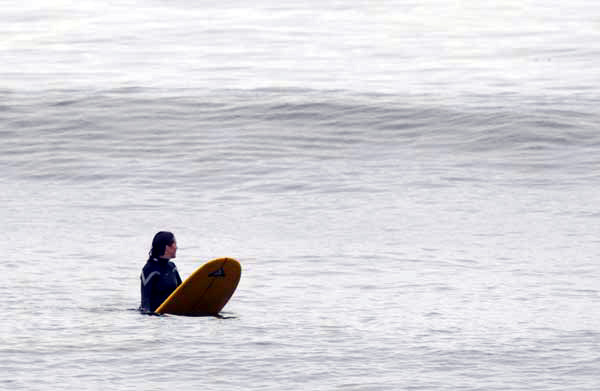
Waiting for a wave.

Waiting for a wave.
The Joy of Surfing
Sitting on your board you look behind you and try to spot an oncoming wave. Your eyes and brain and body have learned to judge the timing so you can catch that wave and ride it. You paddle hard, and feel the acceleration as the onrushing mass of water boosts you to its speed. Then you stand in balance on the board and savor the forces you feel as you crank off some turns. When you decide to end your ride you step back on your board dropping the tail into the water, putting on the brakes.
The Joy of Physics
Throughout all of this you didn't need to whip out a calculator to figure out what was going to happen next, but there is a great deal of physics behind riding a wave. Let's take a look at a few places where physics and surfing meet. We'll start as the surfer starts, waiting on the board between sets, then we'll examine the acceleration as the surfer catches the wave, and finally we'll look at the forces on the surfboard as it turns.
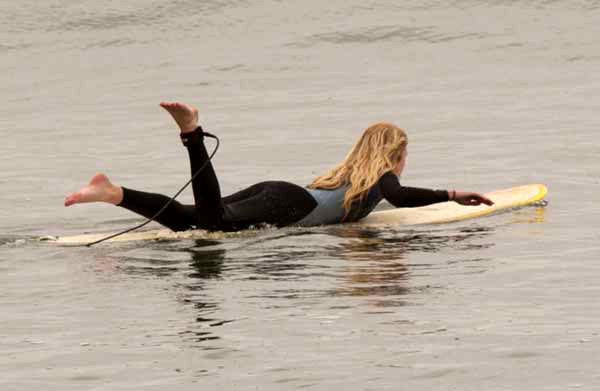
When you are laying on your board in still water between sets. There are two important forces at work gravity and buoyancy. Luckily these forces are pretty simple.

Gravity pulls on every atom in you and your board yet it acts as if it were one force acting at your center of mass. In most people, their center of mass is conveniently located just behind their naval in the middle of their body, as they standup straight. (Well start out by ignoring the mass of your surfboard, the surfboard isn't massless, but physicists tell these little lies all the time to help them get to the heart of a problem.)
Buoyancy is an upward force created as the still water pushes up on the board, a hydrostatic force. The water exerts its force on every part of the board that it touches yet the buoyant force acts as if it were one force pushing up on the board at the center of buoyancy, which is the center of mass of the water displaced by the board. (When Archimedes discovered the mathematics of buoyancy he became so excited he ran naked through the streets of Athens shouting Eureka! or so the legend goes.)
Net Force Since you are staying in one place you are not accelerating and thanks to Mr. Newton we know that the sum of all the forces on you is zero, this is called the net force. No acceleration means no net force. It's great to know the answer before you start to look at the physics. Note that you can sill be moving a constant velocity even when the acceleration is zero, acceleration produces changes in velocity.
Balance is the most important thing to learn as a surfer. If the downward force from gravity and the upward force of buoyancy are in line they add to zero and things are stable. Slide backward on your board and the downward force of gravity moves behind of the upward buoyant force. When two opposing forces get out of line then the board will experience a twisting force, a torque. When you move backward the torque twists the board so that the nose begins to go up and the tail begins to go down, this changes the position the water displaced by the board and also the position of the buoyant force The board rotates until gravity and buoyancy come into line again. Thus by shifting your weight relative to the center of mass of the board you can tip your board nose down, nose up, right side down or or left side down.
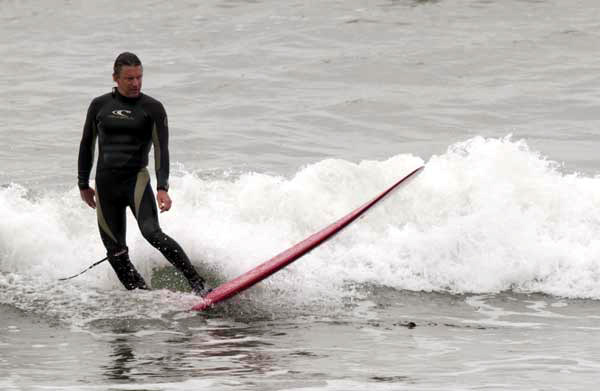
Move back behind the center of mass on a surfboard and the
nose of the board tilts up until the buoyant force lines up with
gravity.
This surfer is in motion to the right and the tail of the board
pushes hard on the water it is moving through bringing him to a
stop.
Physics Force Diagrams
First the surfer moves back.
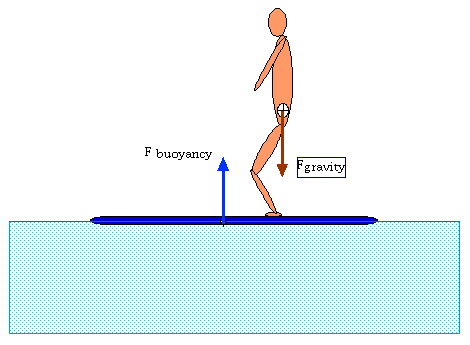
When the surfer moves back on the board gravity and buoyancy
create a twisting force or torque on the surfboard. The board rotates
until the forces come into line again.
Then the board responds by rotating.
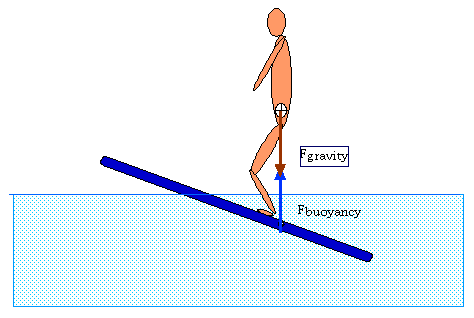
The surfboard rotates until the buoyancy force through center
of mass of the displaced water is aligned with the gravity force on
the surfer. As the board rotates the center of buoyancy, the center
of mass of the displaced water, moves aft. There is then no
torque.
Wave Speed Looking out you see a wave. A nice roller, moving toward you at constant speed. You know from experience that when it reaches you it will be traveling about 6 knots. Judging your timing just right you start to paddle forward accelerating up to a speed that will allow you to catch the wave. Judging which wave to catch and the exact timing needed to paddle out to catch it is one skill a surfer must develop. The physics here is simple, you push water backwards with your hands and by Newton's law of action and reaction, the water pushes forward on you accelerating you up to speed.
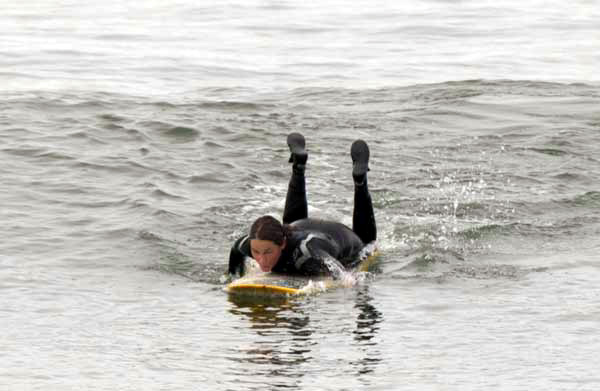
When you push back on the water, the water pushes forward on
you accelerating you to a speed necessary to catch a wave.
The Ride Begins As the wave reaches you the surface of the water begins to tip at an angle, think about that, liquid water sloping at an angle! This can only happen because the water is in motion. You can see the water move in a wave by watching bits of seaweed or foam accelerate up the front of the wave. As the water rises under you, you find yourself on a slippery slope. Gravity is pulling you down that slope, buoyancy pushes you up and new forces, hydrodynamic forces from the interaction of moving water with the surfboard push you forward.
Position yourself just ahead of the crest of a wave and you can slide down the front of the wave. You feel acceleration as gravity pulls you down the wave and the wave pushes you forward and up.

As the surfer catches the wave the water pushes the surfboard
forward. At last the net force is not zero!
The net force accelerates the surfer to the speed of the wave and
beyond.
Hydrodynamic Forces: Feel me See me. A great deal of the complexity of surfing is hidden within the hydrodynamic forces. These are the forces exerted on the surfboard by moving water. Next time you are in a boat or sitting next to a rushing stream (and can safely do so), put your hand in the moving water. Feel the forces that the water exerts on your hand. Tip your hand to the side, feel the force push your hand to the side and watch the flow of water deflect to the opposite side as it collides with your hand. The water moving up the front of a wave collides with the surfboard and is deflected to the side. You can see the result of the collision by watching the spray of water squirting out around the edges of the surfboard. The hydrodynamic forces also include drag forces as water slides along the bottom of the surfboard. The hydrodynamic forces are potentially quite large, as any surfer who has fallen under a breaking wave can attest. Very subtle shaping of the bottom of the surfboard can strongly affect the performance of the board. Channels, concavities, rocker, shapes imposed on the bottom of a surfboard that can hardly be seen or felt without comparing them to a straightedge can change the hydrodynamic forces on the board substantially.
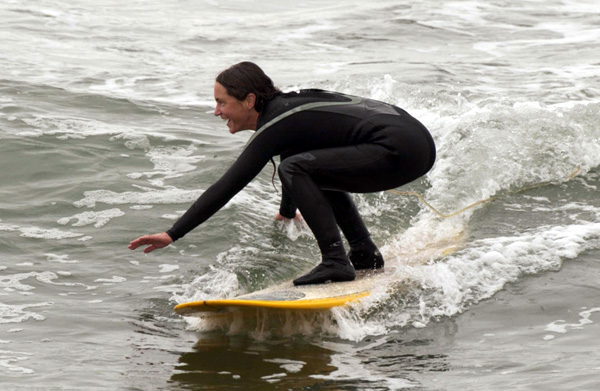
Notice how Lori reaches back from a deep crouch to touch the
moving water of the wave. She's riding a longboard which floats high
in the water.
You savor the rush of acceleration as tons of moving water push you faster and faster. You stand up on the board knees bent, hanging loose, balancing side-to-side, and front-to-back, keeping the continuously changing forces and torques in balance. In a sense you are dancing with the hydrodynamic forces.
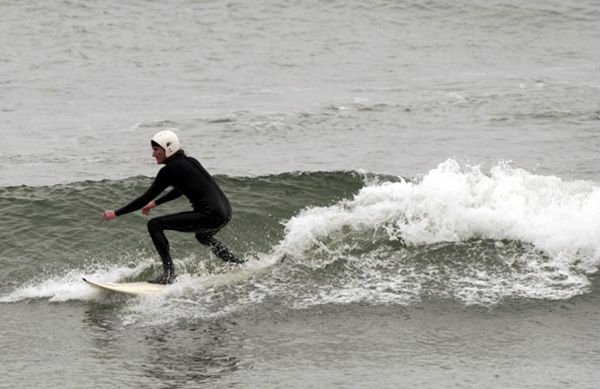
Taking a ride down the face of a wave. Ahead of the break, in
balance, knees bent.
A rider moving along the face of a wave can travel at a speed faster
than the wave itself.
Eric is riding a shortboard.
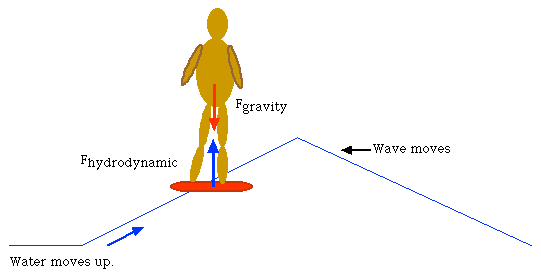
Once the surfer is up to speed on the wave the sum of the forces and
torques is zero.
All of the hydrodynamic forces of the moving water on the surfboard
add up to cancel gravity and make the net force zero.
The Wave Breaks As the wave moves into shallower water the mass of water that is the wave begins to interact more with the sandy bottom of the sea. The lower part of the wave slows, the top keeps going forward, so the wave steepens and breaks. You don't want to be broken, and every cubic meter of water weighs a ton. But if you have chosen a good surfing location the wave doesn't close out and break all at once it peels left to right, or right to left. By leaning the board to the side you can steer so that you stay on the wave just ahead of the break on the steepest part of the wave, the shoulder. (Eric is doing this in the above photo.)Here you can play with energy, dropping down the face of the wave gaining kinetic energy, the energy of motion, and losing gravitational potential energy, the energy of being high, while gravity pulls you down, later, by turning up the face of the wave, you can trade the back energy of motion for potential energy, rising to the crest of the wave. Turning up and down the face of a wave is the soul of surfing.
Turning
Rocker Examine the bottom of a surfboard and you will note that it curves gently up and the tail and at the nose, this is called the bottom rocker of the board. The rocker at the rear helps you to turn the surfboard.
Push on the Water and it Pushes Back You're sliding down the face of a wave and notice that the wave is breaking to your left and is peeling to the right. You want to turn right. On a longboard you step back and shift your weight to the right. [image of longboard surfer] (On a shortboard you shift your weight back and right, put your weight more on your back foot then weight the heels or toes whichever is on the right side.) You've moved the force you exert on the surfboard back and right from where it was in balance. The board responds by rolling a bit to the right pushing the right rail into the wave, the rocker at the tail of the board pushes on the water. A person watching from the shore can see the water spray to the sides as you push it out of the way. The forces of the water on the curved bottom of the rear of the surfboard cause the board to rotate to the right.
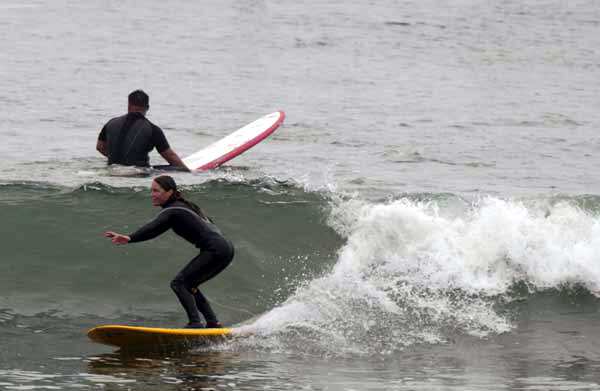
Look at the path recorded in the water behind Lori and you can
see she is turning.
You can look at her board and see it is tilted to the right and to
the rear, Lori is weighting her rear foot toes to make the board
turn.
Turning Faster If you are surfing with your legs bent into a crouch so deep that you can put a hand out and touch the wave beside you, then in the middle of a turn you can straighten you legs accelerating your body upward, this will push the board down into the water with a force greater than gravity, this extra force will make the board turn faster.
Longboard/Shortboard Turn Shortboards are short, with thin pointed noses, longboards are long, with wide rounded noses. If you pick up a short piece of wood, a foot long 2 x 4 for example and try to twist it rapidly side to side, you'll find that it's easy to turn. But try to turn a three foot long piece and your turning motions slow down. The same is true for surfboards. A longer, heavier, surfboard turns more slowly than a short, light, one. Physicists call the resistance of the board to rotation its moment of inertia.
Longboard/Shortboard Speed A longboard might be slower to turn than a shortboard, but it goes faster when you are paddling it. A general rule for boats is that longer boats have a higher hull speed, i.e. they go faster, than shorter boats the same rule applies to surfboards. This is because a boat or a board makes its own waves as it moves through the water, at the hull speed the wave it makes is highest at the front of the board and lowest at the rear, the board is always going uphill. You can see the wave generated by the surfboard itself in the picture above of the blonde surfer paddling out to sea. As she paddles faster the crest of the wave moves toward the back of the board. A board that is planing or sliding across the surface of the water is not limited by the hull seed, so when a shortboard gets up to speed and planes across a wave its speed is no loner limited by its length.
Fins If the surfboard were to slide through the water sideways, the water would hit the fin or fins at the rear of the board with a strong sideways hydrodynamic force. This force would twist the surfboard around its center of mass until the board aligned with the direction of motion. The fins help turns by keeping the surfboard from sliding sideways across the water.
Exit Eventually the ride comes to an end. You step back on your board digging in the rear and applying the brakes. The wave rolls on under you and you end up on the backside. Smiling, you are ready to paddle out to catch another wave.
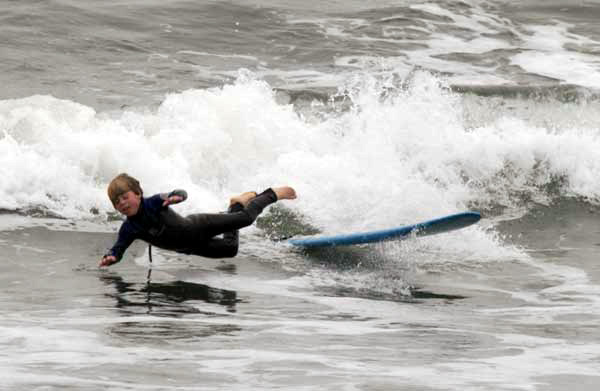
All good rides must come to an end.

Caution, surfing is addictive.
|
Scientific Explorations with Paul Doherty |
|
8 January 2003 |